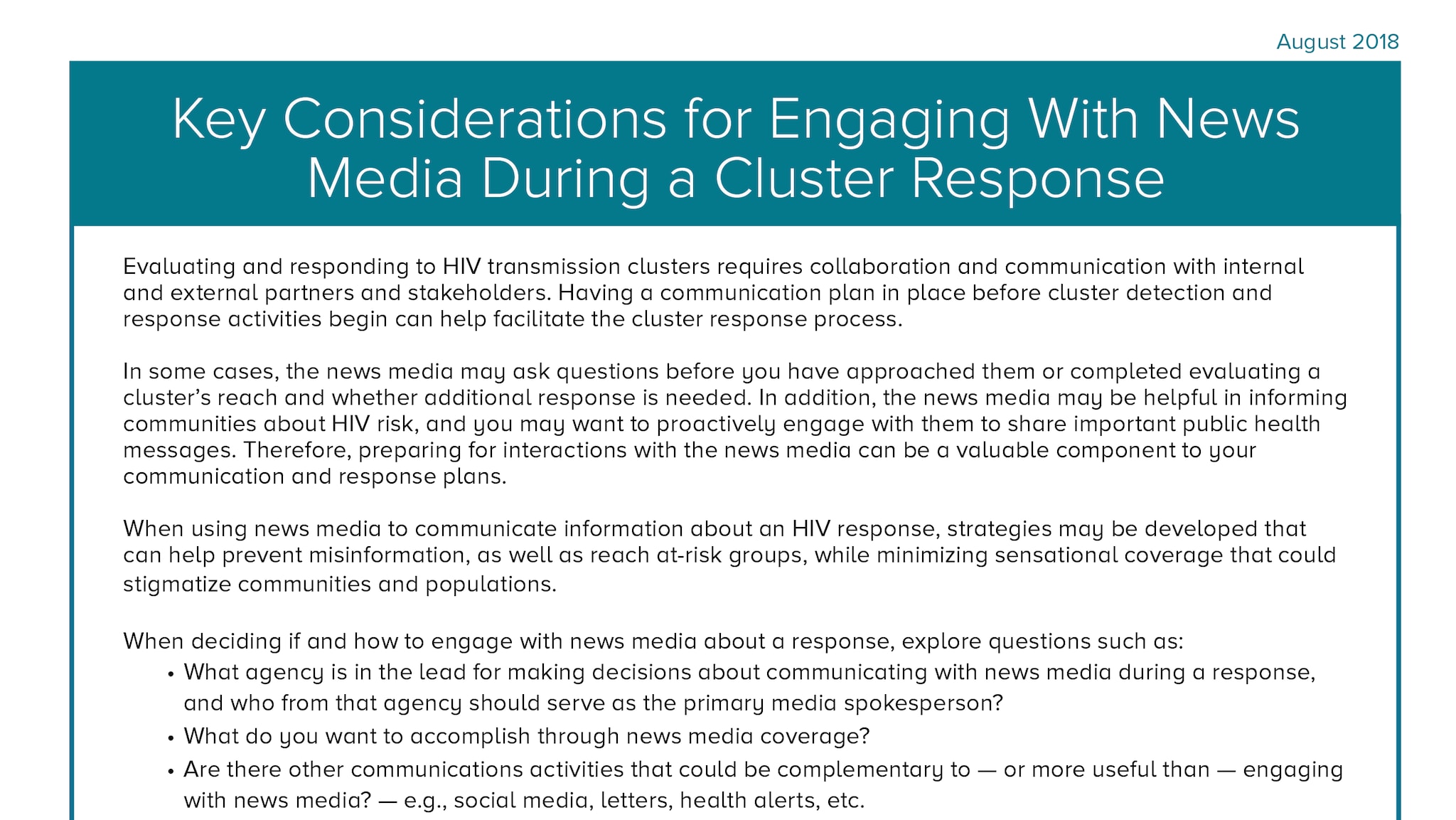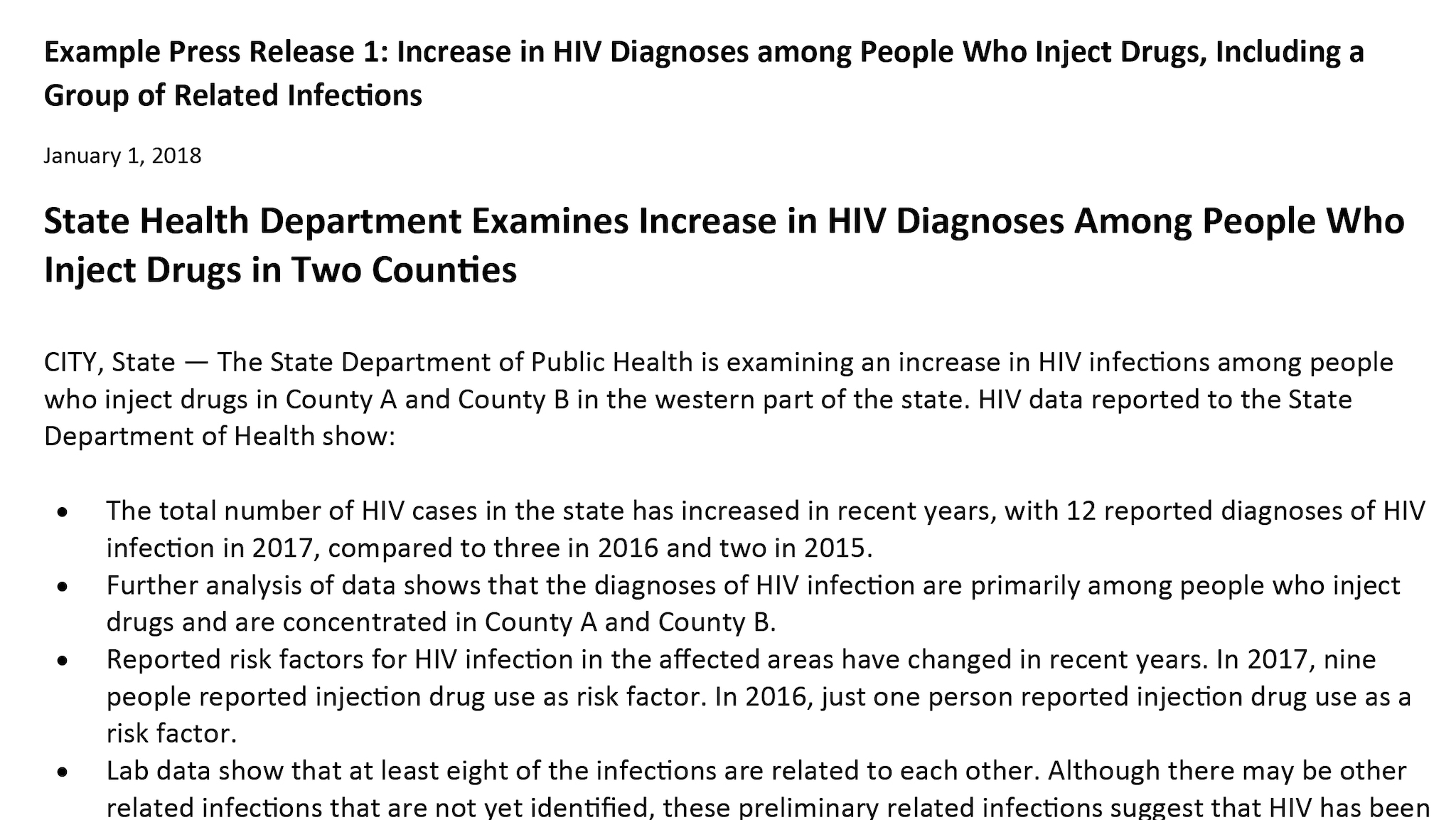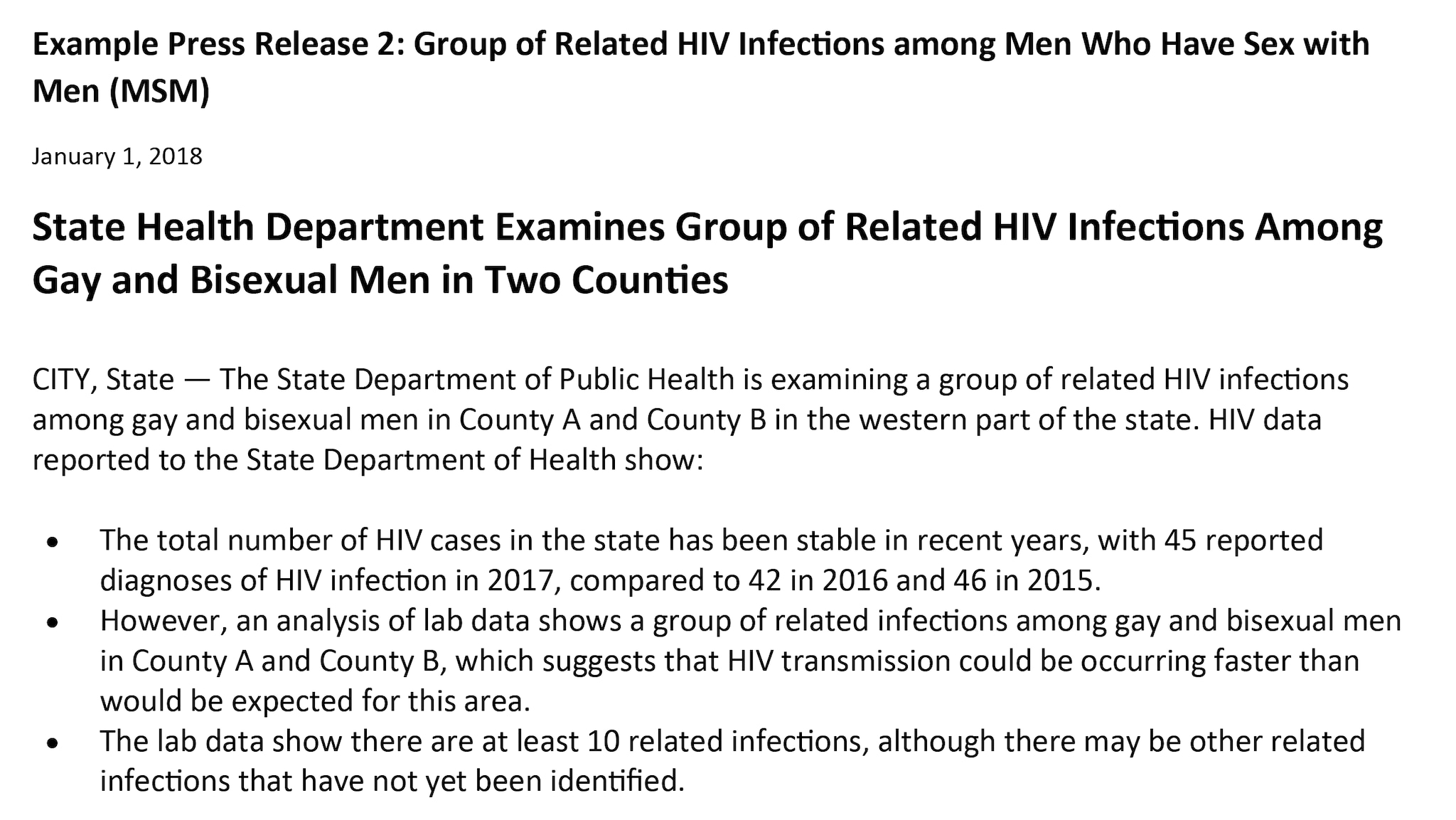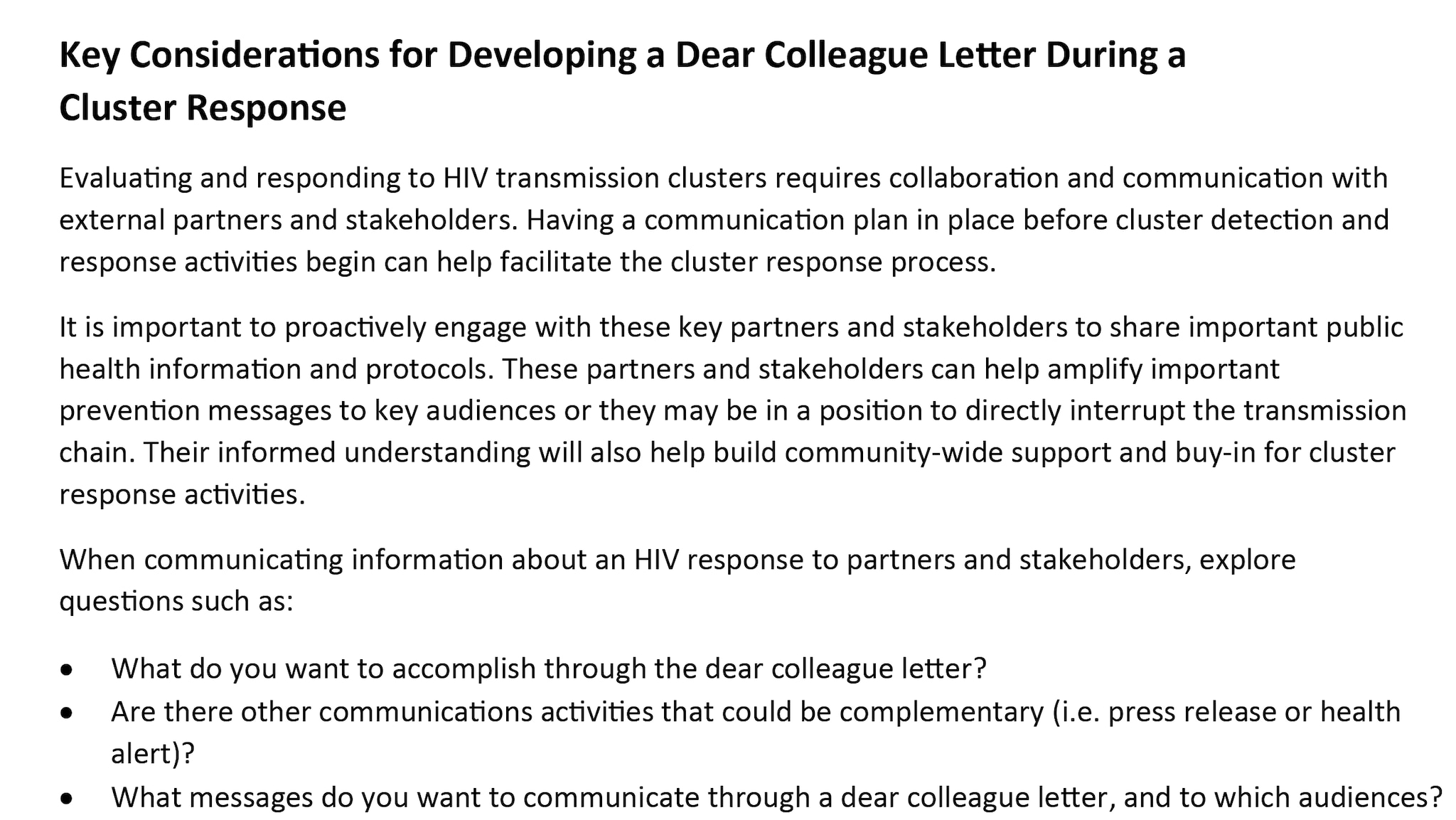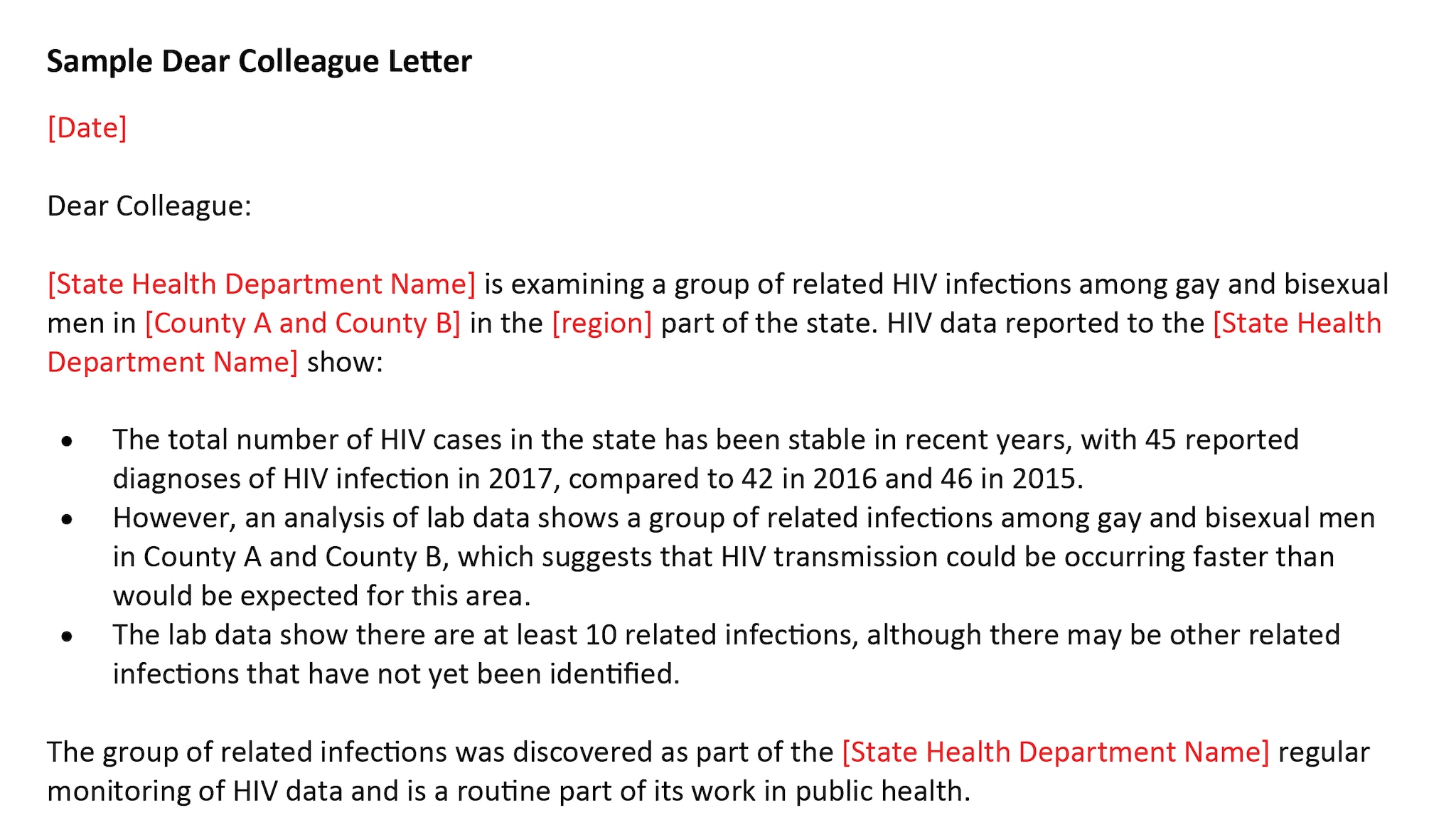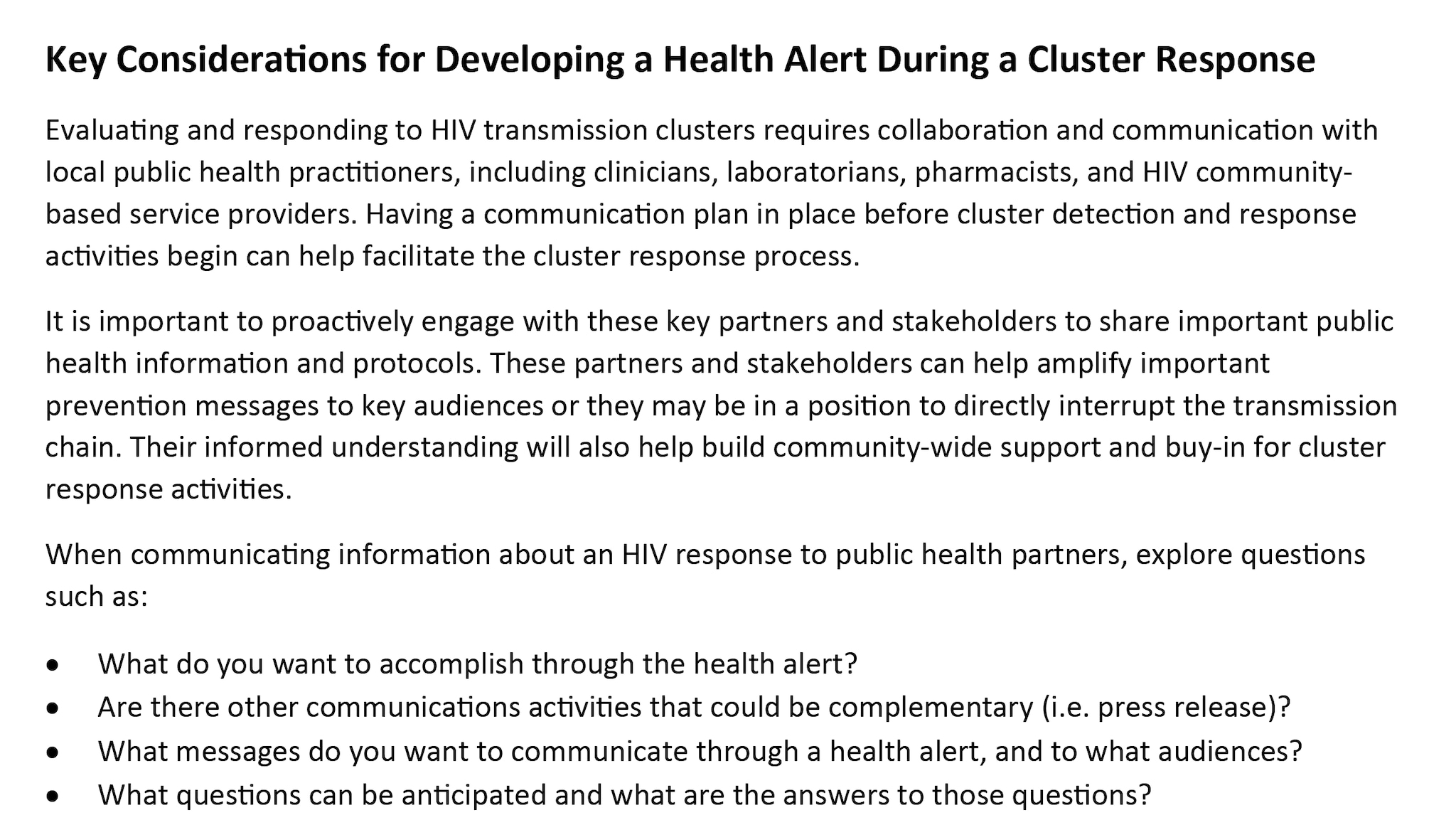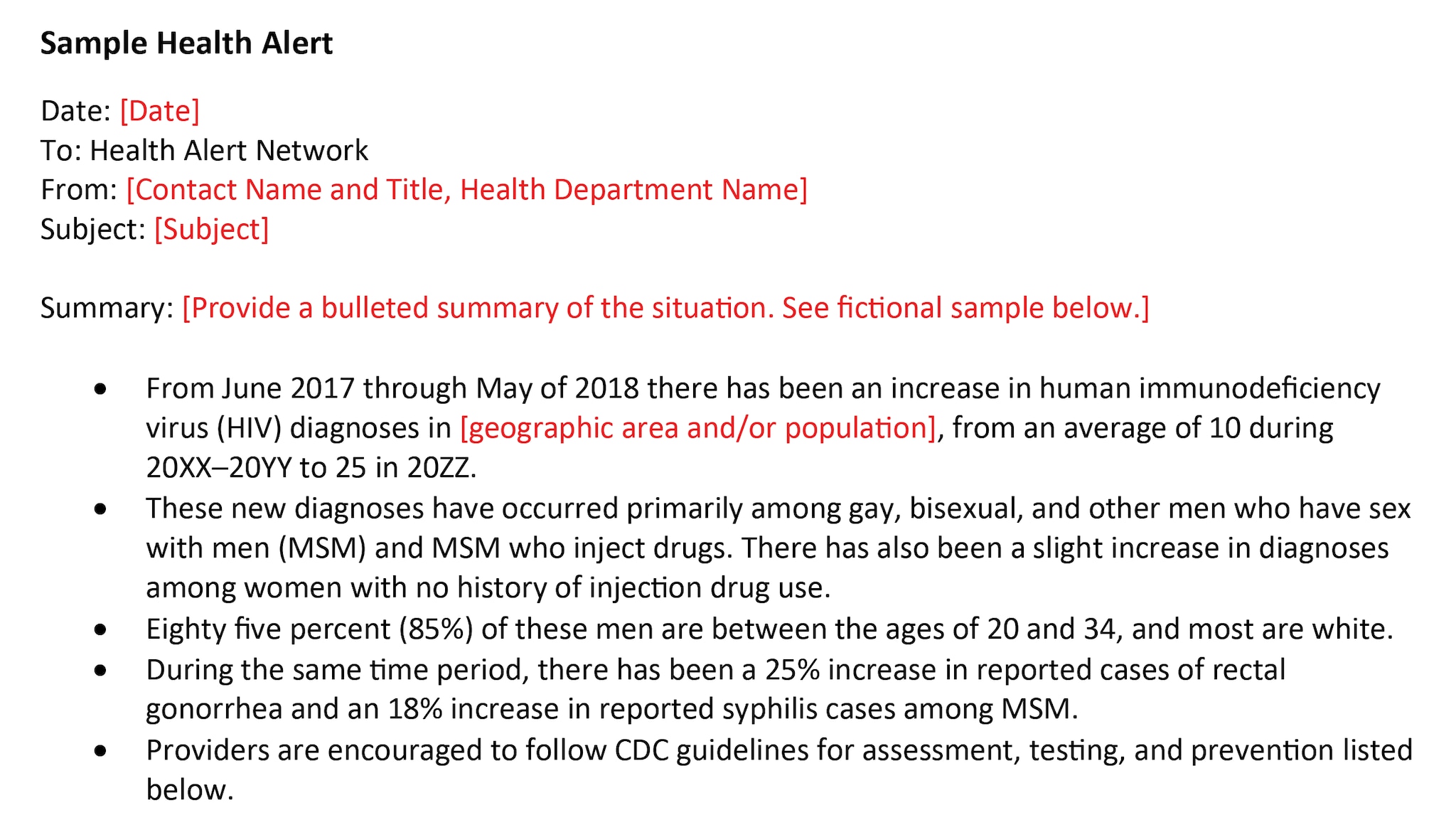About
HIV cluster detection and response (CDR) identifies communities affected by rapid HIV transmission. CDR helps public health agencies and communities identify where to boost HIV prevention and treatment services and programs. These services may include linking people to HIV testing, medical care, pre-exposure prophylaxis (PrEP), and syringe services programs. Real-time CDR is key to stopping HIV transmission and is a pillar of the federal Ending the HIV Epidemic in the U.S. initiative.

Overview
The benefits of HIV cluster detection and response
Many communities have successfully used CDR strategies to
- Improve HIV care and viral suppression outcomes,
- Increase HIV testing and use of prevention services, and
- Reduce HIV transmission.
CDR can reveal gaps in HIV prevention and treatment services. State and local health departments, medical and social service providers, community-based organizations, and others then work together to address these gaps.
An HIV cluster or outbreak signifies increased HIV transmission among a group of people in an area or in a sexual or social network. This can indicate gaps in HIV prevention or care for that group of people. Tailoring services to the people in the network helps bring HIV prevention and care to people who need it and helps prevent transmission.
Identifying HIV clusters
HIV clusters or outbreaks refer to the rapid HIV transmission of HIV among a group of people in a sexual or social network, or in a specific geographic location. CDC and health departments can identify HIV clusters or outbreaks in a few different ways. Sometimes, public health agencies use more than one method to understand HIV transmission in a network. This approach provides more complete information to public health departments and communities to help people with a new HIV diagnosis get the information and services they need and prevent further transmission.
Cluster detection can be done in different ways:
- Medical providers, public health staff, or others in the community may notice an increase in HIV diagnoses among a specific group of people.
- CDC and health departments analyze HIV surveillance data and may identify areas where HIV diagnoses are increasing.
- Molecular data analysis can also help identify HIV clusters or outbreaks.
- Health care providers conduct drug resistance testing as a routine part of clinical care to find the best HIV medication for their patients. This testing generates genetic sequences from the virus (not the person). These sequences are a portion of the larger HIV genome.
- CDC and health departments can then analyze these sequences to identify groups, or clusters, of similar HIV sequences. Because HIV mutates quickly in each person's body, similar genetic sequences in the virus indicate rapid transmission.
- Molecular data analysis can help detect HIV clusters and outbreaks more rapidly and comprehensively than had previously been possible.
Molecular data analysis has helped to identify hundreds of growing HIV transmission clusters across the United States, many of which were not detected before. In some cases, health departments have noticed an increase in diagnoses and identified clusters. Later, molecular data revealed that these cluster were much larger than initially thought.
Molecular data can also be compared across geographic areas to help public health officials find out if a cluster or outbreak is contained. These data can tell if a cluster or outbreak is limited to a single community or expands across counties or even across states.
Responding to HIV clusters
When public health agencies identify an HIV cluster or outbreak, they can work with local partners to address a community's specific needs. The partners may include health care providers, advocates, and other community leaders and organizations. The response can be broad, reaching people in the affected networks, including
- People with undiagnosed HIV,
- People with diagnosed HIV who might not be accessing HIV care or other services, and
- People without HIV who would benefit from prevention services.
Public health agencies can scale responses to the size of the cluster or outbreak and the needs of the people affected by it. CDR work routinely identifies and prioritizes clusters, responds to small clusters, and expands or escalates responses when needed. Responses can have long-lasting benefits beyond the people affected by the initial cluster. For example, agencies have established new community collaborations dedicated to HIV prevention, and expanded testing and PrEP services in an area.
CDC's role in HIV cluster detection and response
CDC provides funding and guidance to health departments to support CDR work, including response preparation and planning. CDC also helps state and local public health staff identify and respond to clusters or outbreaks. In addition, CDC assists and advises public health staff who are responding to a cluster or outbreak, and may provide direct staffing to support response needs.
Frequently asked questions
Many of the questions CDC receives about CDR focus on cluster or outbreak detection, as reflected in the Frequently Asked Questions below. The detection part of CDR identifies increased HIV transmission, which is only one part of the intervention. The response part of CDR is a comprehensive and customizable framework to identify and address gaps in HIV-related services delivered to people experiencing rapid transmission.
In public health, the term "cluster" refers to a group of health events that are somehow related or have some characteristic in common. An "outbreak" is when the number of these events is higher than what would routinely be expected in an area or among a specific group in a given time period. Often, a cluster involves just a few people and an outbreak involves a larger number. Much of the time, there is no clear line between a cluster and an outbreak and either term could apply.
For CDC's purposes, HIV clusters or outbreaks refer to groups of people that are experiencing rapid HIV transmission. The terms are sometimes used interchangeably, and CDC typically defers to state and local health departments on how they characterize a given situation. Using proven response strategies helps jurisdictions respond to HIV clusters or outbreaks quickly and appropriately.
Advances in HIV diagnosis, treatment, and prevention have made it possible to envision an end to the HIV epidemic. New tools can identify rapid HIV transmission, enabling public health staff to respond by identifying and addressing gaps in important treatment and prevention resources. Examples of gaps that may allow for rapid HIV transmission include:
- Missed opportunities for testing;
- Low linkage to care;
- Inadequate access to PrEP;
- Limited access to sterile injection equipment; and
- Other service delivery strategies that do not meet clients' needs.
Addressing these gaps can help stop further HIV transmission by quickly expanding access to HIV prevention and care. For these reasons, responding quickly to outbreaks is a key strategy of the federal Ending the HIV Epidemic in the U.S. (EHE) initiative.
A cluster indicates a gap in HIV treatment and prevention services. Cluster detection and response does not just identify transmission, it is an opportunity to curate highly focused and tailored interventions, such as specialized care coordination, where general interventions have failed. Cluster detection and response uses epidemiology to alert health departments of the need to tailor HIV resources to people who need them, rather than expecting people to navigate difficult-to-access resources in a system that is not meeting their needs.
CDR is vital to ending the HIV epidemic and requires thoughtful and transparent engagement with communities and community partners. Because of this, CDC guidance for CDR efforts requires health departments to engage with their local communities. This engagement helps ensure that implementation of these strategies is responsive to local context and reflects community and partner perspectives.
CDC also values direct engagement with people with HIV and those with lived experience, community-based organizations, health departments, and others. Through multiple forums, CDC has held many discussions to address questions and concerns about CDR strategies, including molecular data analysis. CDC continues to support community and partner engagement at the federal, state, and local levels.
CDR provides opportunities to identify and address gaps in HIV prevention and care services. Community and partner engagement can provide important insight to inform and strengthen these interventions.
Molecular HIV sequence analysis cannot determine if a specific person transmitted HIV to another person. Molecular data analysis examines the genetics of the virus, not the person — and only a fraction of the total HIV genome is reported. These partial sequences are the result of a routine test that helps a healthcare provider know which HIV treatment regimen will be most effective for their patients. They are also used to help identify where rapid HIV transmission is occurring. Viral genetic sequences are not unique to individuals, and dozens of individuals may share very similar viral sequences.
CDC has issued guidance that health departments should not attempt to determine transmission direction or prove direct transmission between individuals. Doing so has little public health benefit.
CDC understands the importance of protecting individuals' privacy and has put strong security measures in place to ensure that HIV data are protected at CDC and in health departments. HIV data held at CDC are strongly protected by an Assurance of Confidentiality under Section 308(d) of the Public Health Service Act. The Assurance of Confidentiality guarantees that all information is held in strict confidence; used only for the purposes stated in the Assurance of Confidentiality; will not otherwise be disclosed or released without the consent of the individual or institution; and that this protection lasts forever, including after death.
As a condition of receiving CDC HIV prevention funding, state and local health departments must comply with strict standards for data security. Those standards require that before any HIV data are sent to CDC, personally identifiable information such as names must be removed, and all data must be encrypted during transfer and when stored.
CDC also provides guidance to state and local health departments on the collection and use of HIV sequence data. To ensure this guidance is followed, CDC requires states to specifically assess protections in place to prevent the release of public health data for any non-public health purpose (including for use in criminal cases), while also requiring states to develop action plans to address any gaps in data protection.
To proactively ensure the privacy of people with HIV, CDC has provided guidance about HIV sequences collected in health departments and CDC. Laboratories conducting genotyping have traditionally used a method called Sanger sequencing. Many labs are now moving to what is called "Next Generation Sequencing" also called "Next-Gen" or NGS.
"Raw" NGS sequences contain more information than Sanger sequences or consensus NGS sequences – like a high-definition version compared with a low-definition version – and could potentially provide more information on direction of transmission compared to Sanger sequences. In the case of HIV surveillance, CDC has decided that this level of detail is not needed for public health purposes, and that Sanger or consensus sequences (which contain the most common base pairs in a given position on a sequence) provide an adequate level of detail for public health purposes without increasing risks of these data being used inappropriately to try and determine direction of transmission. Current HIV data systems only allow for submission of Sanger or consensus sequences; the guidance is intended to address potential future changes in HIV reporting systems.
Furthermore, CDC has provided guidance to health departments that HIV sequence data reported to HIV surveillance programs should not be released to GenBank or other public repositories by health departments or other academic partners without individual consent.
State and local health departments can protect the data of people with HIV, regardless of their jurisdiction's HIV criminalization laws and practices. CDC guidance states that CDC-funded HIV programs should not release personally identifiable information to anyone outside of public health except in circumstances involving significant risk of harm to the public or if required by law. Even when required, only the minimum information should be released.
Ending the HIV Epidemic in the U.S. requires addressing structural barriers to HIV prevention and care. After more than 30 years of HIV research and significant biomedical advancements to treat and prevent HIV transmission, some state laws and practices are now outdated and do not reflect our current understanding of HIV. In many cases, these laws have been shown to discourage HIV testing, increase stigma, and exacerbate disparities. Current scientific and medical evidence should inform state laws and practices that criminalize behaviors by people with HIV. States should consider updating or repealing outdated laws and practices. To end the HIV epidemic, public health, criminal justice, and legislative systems must work together to ensure that laws protect the community, are evidence-based and just, and support public health efforts.
Healthcare providers and clinical laboratories are required by law to report certain types of infections to their local or state health departments. Separate consent (beyond basic medical consent for testing or care) is not required for reportable conditions mandated by state laws or regulations.
HIV is a reportable condition by law/regulation in all 50 states and Washington, D.C., as well as six U.S. dependent areas. CDC funds state and territorial health departments to collect data on persons diagnosed with HIV; all personal identifiers are removed from the data before being transmitted to CDC via a secure data network. Most states also require HIV-related lab data (including all CD4 and viral load data) to be reported to state health departments. These lab data are an essential component of HIV surveillance systems. They provide information that helps direct HIV prevention resources to jurisdictions where they are needed most and inform community-based HIV prevention and treatment efforts.
No. HIV surveillance data stored at CDC do not contain any personally identifiable information, including individuals’ names, addresses, or social security numbers. Individual-level HIV surveillance data that are stored at CDC are strongly protected from release by legal agreements with states and through a federal Assurance of Confidentiality. CDC does not share data that contain individual-level HIV surveillance data. In fact, the Assurance of Confidentiality prohibits CDC from sharing any information that might allow a person to be identified with the public, with family members, for civil or criminal litigation purposes, or with other non-health agencies of the federal, state, or local governments, including immigration-related agencies.
Public health staff have long used cluster detection and response strategies successfully for many diseases.
Although the use of molecular data analysis is relatively new for HIV, public health staff have used it for many years to track other disease outbreaks. For example, molecular data have also been critical to identifying outbreaks of tuberculosis for more than 15 years. More than three-quarters of recent TB outbreaks were first identified using molecular data.
In addition, molecular data have been critical to identify foodborne illness outbreaks, which may be geographically dispersed. PulseNet, CDC's molecular system for detecting foodborne outbreaks, which started more than 20 years ago, is estimated to avert more than 250,000 illnesses from Salmonella annually.
Stories from the field
These community spotlights offer a glimpse at cluster and outbreak detection and response efforts across the nation, highlighting a range of cluster detection tools, cultural contexts, and community benefits. Despite differences, the stories are linked by a strong common thread: in each case, detection of the cluster exposed profound unmet community needs and catalyzed urgent efforts to implement more effective approaches to HIV prevention. The experiences of community leaders and health officials involved in these responses can provide a model to others seeking to implement long-lasting changes that will benefit entire communities.
In early 2021, while conducting routine data analysis, state health officials in Atlanta, Georgia, identified several rapidly growing clusters of new HIV diagnoses. Like other Southeastern states, Georgia experiences relatively high HIV rates overall, but these clusters were the first identified that predominantly included young Hispanic and Latino gay and bisexual men.
Without the data analysis, the scale of the growing clusters among this community might have otherwise been difficult to see because the people affected were living in multiple Metro Atlanta counties. Most were in Cobb, DeKalb, Fulton, and Gwinnett Counties—all of which participate in the federal Ending the HIV Epidemic in the U.S. (EHE) initiative.
- Dorian Freeman
By the middle of 2022, the clusters included 75 people with recently diagnosed HIV, more than half of whom identified as Hispanic or Latino and 4 in 5 of whom reported being gay or bisexual. The continued growth of the clusters suggested considerable gaps in prevention services for young gay and bisexual men that left them susceptible to HIV infection.
As the clusters grew, state and county health departments needed to identify gaps in the prevention and care structure and develop strategies to close them. They first sought insights from people directly affected by the HIV cluster. They mailed questionnaires to people with HIV whose infections were closely linked in the clusters and Spanish-speaking volunteers called to follow up. They also offered gift cards to encourage people to respond, but very few responded. Experts involved say that language barriers, fear of stigma, concerns about immigration status, and mistrust of government likely discouraged many individuals from sharing information.
Meeting the community where they are
Recognizing the importance of hearing directly from the community before taking other steps, local and state health officials visited service providers, clinics, bars, and nightclubs to ask people about local barriers to HIV prevention. They conducted individual and group interviews with 29 community members and 65 medical and social service providers.
State and county leaders also partnered with local organizations that serve Hispanic and Latino communities.
- Eric Rangel
Health officials learned from the community that young gay and bisexual Hispanic or Latino men were often unaware of available HIV prevention tools and services. Language and cultural barriers were common: few area healthcare providers spoke Spanish, and HIV prevention and other health campaigns and materials were almost entirely in English. Many individuals seeking care also didn't feel comfortable navigating the healthcare system.
Atlanta's Hispanic and Latino communities also have their own unique needs and values. That meant that simply translating existing English-language materials into Spanish might not be effective. Neither would borrowing Spanish-language approaches and materials that may have been successful in other parts of the United States.
- Gilda Pedraza
Community interviews and input from providers also revealed other logistical and personal barriers to HIV care and prevention, ranging from lack of transportation and cost to stigma and mistrust. Identifying these challenges gave health officials the information they needed to design more tailored, convenient, and welcoming services.
Responding to community needs
One quick fix was to translate the state's application form for the federal Ryan White program into Spanish. This program provides HIV care and treatment for people without adequate health insurance. Other solutions included reimagining existing or developing new educational materials and Spanish-language social media campaigns. Health departments specifically designed these to reach Hispanic and Latino communities in the Atlanta metro area.
- Dr. Carlos Saldana
This response also accelerated longer-term efforts to recruit and train health workers who could build stronger understanding and trust with the community. Several Metro Atlanta counties have made concerted efforts to hire more Spanish-speaking staff with rapport in the local communities. Hiring more of these staff members will help provider-client communication, which is critical to helping clients feel safe and welcome.
Guided by these goals and equipped with Ending the HIV Epidemic in the U.S. (EHE) initiative funding, GNR Public Health hired four bilingual health providers and support staff. The new Spanish-speaking employees include a health educator, patient navigator, a community health worker, and a nurse focused on mobile engagement and provider outreach.
Metro Atlanta providers now offer services in convenient locations outside of clinics, including pharmacy-based HIV testing events and pre-exposure prophylaxis (PrEP) referrals at nightclubs. Ultimately, each community’s unique needs inform service locations. Providers are starting to bundle HIV prevention together with other routine health services, such as blood pressure screenings or COVID-19 testing. For example, Ventanillas de Salud, which is operated by LCF Georgia, holds health fairs monthly at Atlanta’s Mexican Consulate which now include culturally relevant information about HIV testing and PrEP. A bilingual community health worker offers HIV testing at an OB/GYN office’s monthly community baby shower.
Building a collective response
The cooperation and coordination needed to provide bundled health services and support other metro region-wide efforts quickly became clear. Local health officials say that identifying the HIV clusters highlighted the critical importance of working collectively with the community, with healthcare providers, and with one another. As a result, the response has since grown to embrace community organizations, local service providers, and members of academic institutions who continue to meet regularly.
People engaged in the response also make a point of reaching out to raise awareness of HIV prevention across the affected communities. Some explain the benefits of HIV cluster detection and response to community advisory boards. Others help healthcare providers serving Hispanic and Latino communities better understand how to connect their clients to prevention tools like PrEP.
- Eleanor Garlow
EHE support opened up new avenues for health officials to respond to the clusters. The four EHE counties leveraged and shared federal resources to develop a tailored prevention and care infrastructure benefiting the whole region. For example, the state and CDC created a dashboard to help officials at all levels easily visualize and understand HIV cluster data across the region. Moving forward, trends crossing county lines will be easier to spot and respond to quickly. And these new partnerships and lines of communication also mean that local providers are better able to collaborate and respond swiftly to other emerging health challenges.
"HIV cluster detection and response is complicated, but the key thing to understand is that it can spur action to address issues that might otherwise go unnoticed," says Fulton County's Saldana. "I hope our experience in Atlanta will show others that this approach can drive attention and long-term investment in services for a community that had been overlooked."
In late summer 2016, Amy Bositis, director of clinical programs at the Greater Lawrence Family Health Clinic in Lawrence, Massachusetts, picked up her phone to learn that an acute HIV infection had just been diagnosed in a clinic client. "We provide comprehensive HIV services to our clients, but I had never been called in real time about a patient with a recent diagnosis, because it was relatively rare in Lawrence," says Bositis. "I had definitely never experienced an acute infection being diagnosed among any of our patients."
A few days later, processing a routine report, Bositis realized that two other clients had also recently received HIV diagnoses. Soon, the total of new HIV diagnoses at the clinic grew to five – all linked to use of injection drugs, a route of HIV transmission that over the years had become increasingly rare in Lawrence and nationwide.
Bositis quickly reported this unusual increase in new diagnoses to state health officials, including Dawn Fukuda, director of the Office of HIV/AIDS for the Massachusetts Department of Public Health (MDPH).
"We could tell that something urgent was happening," says Fukuda. "Just before Amy called, I heard that HIV had been diagnosed at the county jail among six people who inject drugs. Altogether, it added up to a third of the total HIV diagnoses linked to use of injection drugs we normally see in a year statewide – but this was in one county, in one month."
Beginning with these initial small groups of people with newly diagnosed HIV, investigators from the state health department, with support from CDC, launched a painstaking, months-long investigation to understand the true scope of the outbreak. The investigation included epidemiologic analysis of HIV data including viral sequences, and interviews with people who inject drugs.
The results were stunning: the investigation ultimately uncovered a network of interconnected clusters spanning 184 people with HIV – many of whom received a diagnosis during the course of the investigation itself. Most people affected by this large outbreak were in Lawrence and in nearby Lowell, though the networks extended across the state and even beyond state lines into neighboring New Hampshire.
- Amy Bositis
The investigation revealed that many individuals in this network were experiencing homelessness or unstable housing. And nearly all had injected drugs – often fentanyl, which had been introduced into the area's drug supply sometime in 2014. Fentanyl can increase risk for HIV transmission, in part because its effects wear off relatively quickly, inducing users to inject more frequently.
Because HIV was being transmitted primarily among people who inject drugs, MDPH began gathering information and insights on the outbreak from a variety of local sources, including clinics, hospitals, and boards of health as well as broader community sources like jails, advocates for people experiencing homelessness, local politicians, and first responders.
- Dawn Fukuda
Together, these stakeholders created profound policy and program changes. The Greater Lawrence Family Health Clinic, for example, completely reorganized the way it provides services in response to what they learned through the cluster investigation. While specialized medical needs and funding streams had typically encouraged the separation of services for HIV, substance use, tuberculosis, hepatitis C, and other health concerns, the clinic shifted to an integrated approach where all of these health issues are addressed together by a small team. Often this team works outside the clinic, bringing services directly to the people who need support most, including people living in homeless encampments.
Within the encampments, law enforcement and other first responders learned as a result of the cluster investigation to adopt a public health approach to people who inject drugs or experience overdoses – referring them to medication assisted treatment for opioid use disorder, rather than taking them to jails for acute detox as they had often done previously. Similarly, homeless shelters began to relax policies against substance use that previously led staff to confiscate needles and syringes, which often caused people who inject drugs to remain on the street rather than using the shelters. Now, in some cases health workers are invited into the shelters to share prevention information, counsel clients, and conduct HIV tests.
The effects of the Lawrence and Lowell investigations rippled statewide. Massachusetts moved quickly to fill the gaps in services identified in the course of the investigation, investing an additional $1.7 million in state funding for HIV prevention. These funds have been used to provide a wide range of services, including expanding testing for HIV and hepatitis C, linking people receiving HIV diagnoses in hospital emergency departments to care, and even providing medication storage for people experiencing homelessness who might need a safe place to keep their HIV medication.
Detection of the outbreak also lent urgency to take advantage of a 2016 change in state law shifting the authority to approve syringe services programs (SSPs) from elected officials to local boards of health. SSPs typically provide comprehensive services, including sterile needles and syringes, Narcan to prevent fatal drug overdoses, and referrals to substance use disorder treatment. In part because of the outbreak, Lawrence, Lowell, and other local boards of health approved these programs, and the number of publicly supported SSPs in Massachusetts grew from just 5 in 2016 to 33 by 2019.
- Kevin Cranston
In early 2019, HIV was diagnosed in three people screened at the Native American Community Clinic (NACC) in Minneapolis, Minnesota. The screening was routine and conducted through the clinic's medication-assisted treatment program for people with substance use disorders. During the previous decade, the clinic had only seen a handful of clients with HIV – so discovering three new diagnoses in just a few months was noteworthy.
Later that same year, the Minnesota Department of Health (MDH) conducted an analysis showing that over the past nine months there had been 18 HIV diagnoses in Minneapolis and neighboring St. Paul among people who inject drugs, more than three times the total in a typical year. This unusual increase prompted the state to initiate a cluster investigation. Using tools including partner services interviews and expanded HIV testing within homeless encampments and at harm reduction clinics, health officials had uncovered 26 linked cases by early 2021. They found that nearly half of the diagnoses were among young Native Americans, who typically make up less than 5 percent of people with HIV diagnosed in Minnesota each year.
"Native Americans don't really show up in HIV data in our area, because the number of infections is so small compared with other groups," says Dr. Kari Rabie, NACC's medical director. "So there hasn't been a focused strategy to support them. This outbreak made their needs visible in a way we hadn't seen before."
Rabie notes that while rates of HIV have typically been low, the Native American community faces a host of health challenges rooted in historical trauma. And because community members are tightly interconnected, once HIV was introduced, it was easy for the virus to be transmitted, especially among people who inject drugs.
With just a few clients with HIV before the outbreak, NACC had always referred HIV patients to infectious disease specialists outside the clinic for their HIV care and treatment. Often clients returned saying they had dropped out of HIV care, because they felt unwelcome and stigmatized. Prompted by the outbreak, the clinic partnered with the Midwest AIDS Training and Education Center (MATEC) on a five-year grant focused on improving HIV capacity. Now, NACC is providing direct, comprehensive HIV care and is in the process of qualifying as an HIV Center of Excellence.
"Learning how to provide HIV treatment services has been a challenge, but also very rewarding," says Jace Gilbertson, nursing manager for NACC's HIV programs. "In a big system, our patients can get lost or pushed to the side. For us, it's different – each person is someone we know and care about. We can provide a place where they feel respected and safe, and meet all their needs whether that be antiretroviral treatment, or help with medical insurance, or sage for smudging," which can be part of a purification ritual conducted by some Native Americans.
Addressing the full needs of clients
The HIV outbreak response in Minneapolis has underscored the importance of addressing social determinants of health. To meet the needs of its clients, the Native American Community Clinic (NACC) improved its capacity and now offers comprehensive, culturally affirming HIV care.
The state-led cluster detection and response effort also revealed that many people receiving new HIV diagnoses reported experiencing homelessness. Like NACC, Hennepin County Health Care for the Homeless stepped up to a leadership role in the response. In early 2020, the group assigned public health nurse Sarah Jane Keaveny to focus on HIV street outreach. Keaveny, who had previously been focused on providing mental health and harm reduction services to people in Minneapolis encampments, travels each afternoon to places where people experiencing homelessness are likely to be gathered.
Keaveny offers her clients a range of critical health care services, including HIV and STI testing, information about HIV prevention, syringe services, help with accessing housing and benefits, and basic health services, such as wound care. Thanks to an innovative telehealth model, she can also now use her mobile phone to help people obtain and use PrEP in the field, without making in-person clinic visits.
As another part of the cluster response, the MDH invited frontline service providers, including Health Care for the Homeless, NACC, and other local and state organizations to come together to share ideas and information about how to improve services for the community. The weekly meetings, called HIV Outbreak Public Engagement (HOPE), are led by Anna Bosch, operations coordinator of the outbreak response for MDH.
- Anna Bosch
Reaching people who don’t visit clinics
The Minneapolis HIV outbreak required a tailored response to meet the needs of people with HIV or those who could be better served by HIV prevention and are experiencing homelessness; new HIV street outreach services address those needs holistically.
"PrEP typically is provided within a clinic-based model, but our clients don't go to clinics, so we've learned to offer it using a street-based model," Keaveny explains. "A doctor can prescribe PrEP over the phone as part of a telehealth visit. I draw blood for testing in the field, and later I can help clients get to the pharmacy or even bring the medications directly to their tent once a week."
The ideas that come out of HOPE meetings underscore the complex, interconnected needs of those affected by the HIV outbreak. For example, participants have urged HIV testing sites to offer food and other incentives.
"People don't think of snacks as an important part of HIV testing, but it certainly is when somebody is sitting there hungry and waiting," says Bosch. "Yes, we have these important clinical services like HIV testing, but HIV testing doesn't happen in a vacuum. These are humans with human needs that come first."
By strengthening the ties among community organizations and creating spaces for organizations to share feedback and insight with MDH, HOPE also helps sustain connections between providers and the highly mobile populations they serve.
"Every time a camp is dispersed, we lose track of the people who were living there," says James Schmidt, who conducts street outreach for NACC. "If someone from another group can help me reconnect with them, I can maintain that relationship and maybe over time convince them to come into the clinic and engage with the system to get the help they need."
These relationships provided essential support to Minneapolis organizations and community members as they experienced COVID-19 lockdowns and widespread community pain and anger following the murder of George Floyd, who died just a few blocks away from NACC.
"This year has challenged us all to redefine what success looks like," says Bosch. "We haven't ended HIV transmission in Minneapolis. But we have created a space where people come together to identify and attempt to solve real, on-the-ground problems – and those are necessary first steps."
When CDC began conducting molecular analysis of HIV data at the national level, researchers were surprised to see a rapidly growing cluster of linked infections diagnosed in and around San Antonio, Texas. The Texas Department of State Health Services (DSHS) and CDC began studying the cluster in early 2017, initially identifying 24 linked infections. Following a full investigation, including reviewing and following up on data from partner services interviews, health officials discovered a network of 87 people with HIV – the nation's largest identified HIV cluster at the time.
Most individuals in the cluster were young gay and bisexual Hispanic/Latino men. That fact was no surprise to the advocates and healthcare providers who had been working for years with this population.
"Many young people haven't received much information about HIV or how to prevent it," says Greg Casillas, assistant director of San Antonio's Thrive Youth Center. "When they test positive, they're afraid to disclose that information to their families or the community, let alone seek treatment. We're a very conservative, closeted city. And that can make it hard for people to learn about HIV."
But the size of the cluster came as a shock.
"Those of us working in the community had been seeing young people coming into HIV care very ill, with advanced infections," says Dr. Barbara Taylor, an infectious disease specialist and assistant professor at the University of Texas Health Science Center in San Antonio. "So, we knew transmission was happening, but it was stunning to learn that we had the biggest cluster in the country [at the time]. Being able to visualize the scope of the problem like that was so important. It pushed us to think differently."
Thinking differently led to a gathering at a local restaurant, where a group of patient advocates, city public health officials, academic medical center staff, and people with HIV came together one afternoon to discuss how to respond. While the participants represented disparate groups, the detection of the cluster made them all acutely aware that something needed to change, including engaging people with lived experiences and focusing prevention efforts to stop transmission in this network.
"It was clear that what we had been doing wasn't working for the younger people represented by the cluster," says Taylor. "We recognized that we needed to take a step back, to listen, and to support people with HIV who were stepping up to take the lead."
When the participants with HIV spoke, the stories they shared quieted the room. One after another, each person spoke of the challenges they faced. They described how hard it was to make and get to care appointments, the long wait times, and the judgmental health workers.
- Glenda Small
After that first meeting, the group decided to gather weekly to share information and plan next steps. To highlight the critical need for more accessible, welcoming prevention and care, they named themselves the End Stigma, End HIV Alliance (the Alliance), and worked to develop and publish clear recommendations for providing stigma-free healthcare services across San Antonio.
Another early priority was expanding HIV testing, to ensure that diagnoses are made as early as possible. In part due to the work of the Alliance and its members, additional healthcare facilities – including hospital emergency departments and some family planning providers – have begun or expanded routine, opt-out HIV testing.
HIV treatment guidelines recommend that people begin treatment as soon as possible after receiving an HIV diagnosis, but only about three-quarters of people identified during the initial cluster investigation had started antiretroviral therapy. To address this problem and get people connected to treatment faster, the Alliance worked with the health department and care providers to create a calendar that shows which providers are available each day to initiate HIV treatment. Armed with this information, testing facilities can help a client with newly diagnosed HIV see a provider and get a prescription for treatment right away. The results are impressive: data from four local agencies show that in 18 months, the median time between HIV diagnosis to an initial HIV care appointment fell from 13 days in July 2018 to just two days.
With support from the DSHS, the Alliance has also helped increase the availability of PrEP in the community. Several facilities that used to focus on HIV testing and treatment have added PrEP services, and there are now more than 25 sites offering PrEP county-wide, compared with just four in 2016.
Detection of the cluster and the response activities led by the Alliance also raised community awareness of HIV, and – advocates hope – fostered a growing openness to discussing the disease and the challenges faced by those affected. During the summer of 2018, the Alliance collaborated with a local theater to create an interactive production drawn from the stories of San Antonio residents with HIV. In 2019, the San Antonio Express-News ran a series of articles addressing the HIV cluster, with special attention to PrEP, HIV testing expansion, syringe services programs, and the role of stigma. A local HIV service organization, Beat AIDS, also sponsors billboards and bus ads promoting testing, treatment, and talking about HIV.
- Greg Casillas
While San Antonio's HIV cluster was larger than any other cluster in the country at the time, the problems faced by the community are not unusual. The city's response offers valuable lessons for others, says Jenny McFarlane, who manages HIV prevention programs for the Texas Department of State Health Services.
McFarlane says, "In San Antonio, they took advantage of the cluster being detected to develop a strong public health response that makes a point of asking about, acknowledging, and addressing the broader needs of their community."

